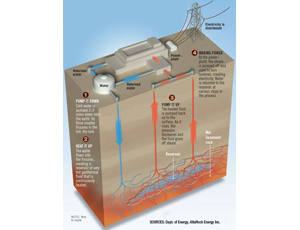Geothermal energy experts are playing down worries about the threat of induced seismicity connected with enhanced or engineered geothermal systems (EGS) following news reports about an earthquake apparently caused by an EGS project in Germany. The project in the western German city of Landau in der Pfalz is continuing operation while a panel of experts evaluates data from the mid-August magnitude-2.7 temblor. Officials of Geox GmbH, the plant’s owner, deny the temblor was caused by their plant.
Globally, about 9,000 MW of geothermal projects are operating today. Most of them tap water heated to high temperatures deep underground by the Earth’s own heat. The water is pumped to the surface to generate steam that drives steam turbines, which generate electricity. EGS is different in that it goes three to 10 kilometers into the Earth, much deeper than other systems. Instead of tapping existing water, it fractures the deep rock with water pumped in at high pressure and extracts the hot water or steam via a separate well to generate electricity on the surface.
It is an appealing technology because deep, dry geothermal energy is much more widely available than conventional geothermal resources. The U.S. Dept. of Energy’s Geothermal Technologies Program currently funds 21 research, development and deployment projects, including four field demonstrations.
Critics claim that fracturing the deep rock can cause earthquakes if the fracturing is too close to an active seismic fault zone. Defenders of the practice hesitate to shrug off the risks but caution against overreacting. “I don’t want to discount the need to address the issue,” says Karl Gawell, executive director of the Geothermal Energy Association, Washington, D.C. “They are correctly concerned about any fracturing.” But the oil and gas industry has been successfully fracturing deep strata since the 1950s to enhance production, he points out.
Massachusetts Institute of Technology produced a report for DOE in January 2007 titled “The Future of Geothermal Energy.” It estimated EGS could “competitively” provide 100,000 MW of additional electric capacity in the U.S. by 2050. In Australia, Geodynamics Ltd. early last year completed an EGS production well in South Australia’s Cooper Basin. On March 31, 2009, the company said it completed proof-of-concept on the 4,221-meter-deep well. Research and development of EGS technology is continuing in several other locations in the world as well.
The leader of the MIT team that produced the DOE report cautions against arousing fears with unbalanced news coverage. What happened in Landau and in a similar 2006 EGS-connected seismic event in Basel, Switzerland, is “not alarming,” says Jefferson Tester, a professor of chemical engineering at MIT. “What you have to consider is, what is the probability of an event that could hurt people or property,” he says. The intensity of the seismic events to date that could be blamed on EGS has been well below the threshold of what people normally consider an earthquake, he notes.


Post a comment to this article
Report Abusive Comment